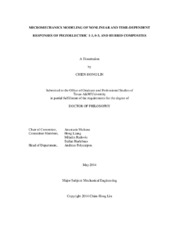| dc.description.abstract | Nonlinear electromechanical and polarization switching behaviors of piezoelectric materials and viscoelastic nature of polymers result in the overall nonlinear and hysteretic responses of active polymeric composites. Understanding the nonlinear behavior of the active polymeric composites is crucial in designing structures comprising of these active materials. This study presents three micromechanical models, i.e., fiber-, particle-, and hybrid-unit-cell models, to study the effective nonlinear and hysteretic electro-mechanical responses of 1-3, 0-3, and hybrid piezocomposites, respectively. The microstructures of the active composites are idealized with periodically distributed
arrays of cubic representative unit cells. A unit cell is divided into several subcells. The fiber- and particle-unit-cell models consist of four and eight subcells, respectively. The hybrid-unit-cell model is derived based on the fiber-unit-cell model of 1-3 active composites consisting of fiber and matrix subcells, in which the matrix subcells are comprised of a particle-unit-cell model of 0-3 active composites. In order to obtain the overall nonlinear responses of the active composites linearized micromechanical relations are first used to provide trial solutions followed by iterative schemes in order to correct errors from linearizing the nonlinear responses. The micromechanical predictions
are capable in predicting the overall nonlinear electromechanical, time-dependent, and polarization switching responses of active composites available in literature. Parametric studies are also performed to illustrate the effects of microstructural geometry and volume content of the piezoelectric inhomogeneities as well as loading history on the overall nonlinear and hysteretic responses of active composites. Finally, a multi-scale analysis of a functionally graded piezoelectric bimorph actuator using the developed particle-unit-cell model is given as an example of practical applications. | en |


